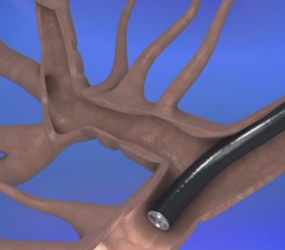Pulmonary Cryobiopsy
What is a Pulmonary Cryobiopsy?
Standard means of achieving biopsies (tissue specimens) from the lung, involve the use of small flexible forceps, passed down the working channel of a bronchoscope (flexible camera), which is directed into your airway from your mouth or nose (bronchoscopy). Unfortunately, these forceps only obtain very small quantities of tissue, which are often insufficient to provide an accurate diagnosis for many lung diseases.
With the advent of miniaturized cryo-probes, we are now able to obtain much larger tissue specimens via the bronchoscope.

How it works
The cryo-probe works via the principle of the Joule-Thomson effect (Wikipedia), allowing rapid cooling of the tip of the cryoprobe down to very low temperatures. This allows quick acquisition of large biopsies via the bronchoscope, as a day procedure. Safety and risks are similar to that of standard bronchoscopic foceps biopsies, and significantly less morbid than surgical lung biopsy procedures.
Video:
Note:
Any surgical or invasive procedure carries risks. Before proceeding, you should seek a second opinion from an appropriately qualified health practitioner.

